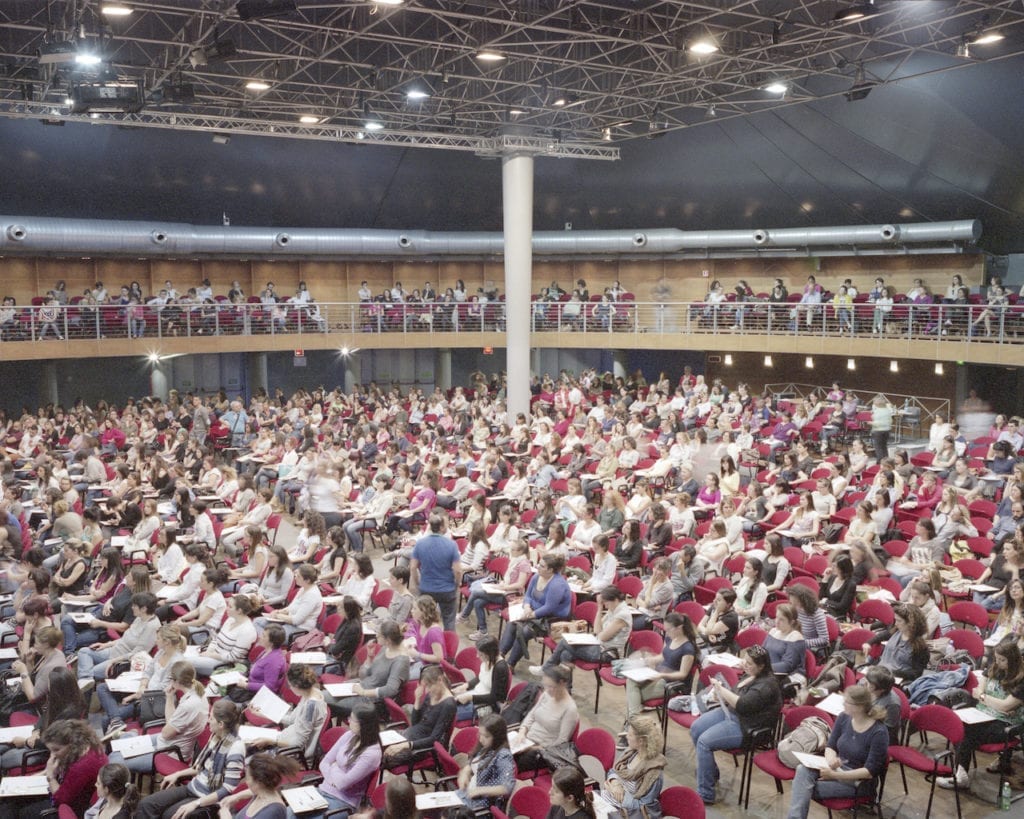The numbers are just staggering – 2813 applicants showing up for nine nursery teacher positions; 10,000 for 14 policer officer roles; and 1099 for one nursing post. These are the Italian Civil Service exams, and Michele Borzoni photographed them for over a year, capturing their sheer size with a medium format camera and a perspective-correcting lens more usually used for large-scale architectural shots.
“I wanted to emphasis this sense of mass, the loss of individuality, the person reduced to number,” he says. “The competitions are sometimes a humiliating path, because often they do not assess the individual capacity, at least not in the early stages of the competition.”
Getting permission to shoot was complicated, says Borzoni, because these entrance tests are “the temples of Italian bureaucracy”; once he was in the room, he also had to ask permission from any applicants who would be recognisable. “Sometimes I asked over the microphone if anyone did not want to be photographed, then asked him or her to get up in order to take the picture,” he says.
This series, titled Looking for a job, is part of a wider project Borzoni is shooting called Workforce. Other elements include a chapter titled Chinese Textile Industry, a look at the working conditions in Prato’s garment factories, and a chapter titled Day Labourers, which records the shocking temporary living arrangements made for African agricultural workers brought in for the harvest.
Another chapter, Union Pickets, details a series of pickets in the traditionally left-wing region Tuscany; Borzoni intends to shoot three more chapters, then publish Workforce as a book.
“It’s an attempt to draw a composite picture of Italy’s current labour landscape, in the framework of the recent global economic recession,” he explains. “I was looking for a different way to represent unemployment – Article 1 of the Italian Constitution is written exactly like this: ‘Italy is a democratic Republic founded on labour’.”

“Working in the public service was always the average Italian dream in the 1980s, or at least the parents’ dream, because it guaranteed financial security,” he says. “Therefore the most common roles – the teacher, the nurse, the policeman, the soldier – are the most popular exams. Statistically, the number of participants in competitions did not increase significantly during the years of the economic crisis, perhaps for lack of trust [in the government].
“Generally the pre-selection test takes less than an hour,” he adds. “But competitors have to arrive hours before the competition to complete all the bureaucratic procedures of recognition and impartiality. In fact there is a great fear that competitions are rigged.”
Borzoi started taking photographs while on a reconstruction project in post-war Bosnia Herzegovina when he was 18, and has studied at New York’s prestigious International Center of Photography. He’s completed two long-term projects on the Kashmir conflict and in the Middle East, but in 2013 made a conscious decision to focus on his homeland.
“After years spent abroad I felt the need to tell a story that has to do with the place where I live,” he says. “I was looking for a story close to me and to my generation.”
Michele Borzoni’s website is at terraproject.net Foto/Industria is at Mast, Bologna from 12 October-19 November www.fotoindustria.it/en/





